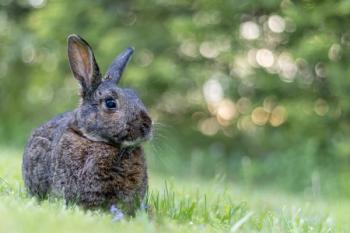
Hernia displaces kitten’s organs, emergency surgery saves her life
A 6-week-old abandoned kitten had both an inguinal and diaphragmatic hernia
When Tuna Sandwich was found, she was in respiratory distress and had a visible inguinal hernia and a diaphragmatic hernia, which radiographs later confirmed. This female kitten was approximately 6 weeks old and was found abandoned not far from a Subway restaurant, from which she got her name. The person who found Tuna Sandwich brought her to the FieldHaven Feline Center, a non-profit animal welfare organization in Lincoln, California, where she was examined by Jennifer Yee, DVM, CPEV, medical director of Fieldhaven.1,2
Veterinarians suspect that Tuna Sandwich’s inguinal and diaphragmatic hernias were caused by a traumatic injury, such as a fall or being struck by a car, a news report stated.1 An inguinal hernia is characterized by a protrusion of the intestines through an opening in the groin. Additionally, a diaphragmatic hernia happens when there is a hole in the diaphragm that allows the abdominal organs like the stomach, intestines, or liver, to move into the chest cavity. The latter is caused by a birth defect or trauma, according to a UC Davis School of Veterinary Medicine report.1
“A diaphragmatic hernia is a severe condition where organs shift into the chest, putting dangerous pressure on the lungs and heart,” said Michael Mison, DVM, DACVS, chief veterinary medical officer of UC Davis veterinary hospital in the report.1 “Timely surgical repair is essential to restore normal breathing, protect vital organs, and give Tuna Sandwich the best chance at a healthy, happy life.”
Given Tuna Sandwich’s critical condition, she was granted an emergency referral to UC Davis’ veterinary hospital’s Soft Tissue Surgery Service. There, Karen Vernau, DVM, DACVIM (Neurology), faculty advisor for the school’s Orphan Kitten Project, and member of the feline pediatric services team led the primary care of the case. Vernau also worked with Mison and Alex Aubrecht, DVM, a surgical resident.
After additional imaging, the team discovered that Tuna Sandwich’s stomach, liver/gall bladder, omentum, small intestines, and spleen were all shifted into her chest instead of being positioned behind her diaphragm in her abdomen. These displaced organs were putting pressure on her lungs, causing the respiratory distress.
One challenge that the team encountered was Tuna Sandwich’s size. Weighing at less than 1 lb, her small size put her at an increased risk for anesthesia and surgery complications. However, “waiting until she was larger wasn’t an option,” explained Aubrecht.1 Due to the severity of her condition, Tuna Sandwich underwent immediate surgery, with Mison and Aubrecht repairing the two hernias.
After the surgery, Tuna Sandwich successfully recovered. However, because of her petite frame, she was kept in an incubator overnight to prevent hypothermia.
Aubrecht attributes the success of Tuna Sandwich’s surgery to the entire team’s effort, according to UC Davis.1 “Every individual involved played a vital role in Tuna Sandwich’s successful outcome, and it is a true testament to the dedication and skill of the entire team,” he said.
“Our exceptional surgery and operating room technicians worked swiftly and efficiently to prepare her and the necessary equipment. The anesthesia team managed her most significant perioperative challenges, ensuring stability, warmth, and prompt responses to anesthetic concerns,” he continued.
The road to recovery
After one night of hospitalization at the UC Davis Veterinary Hospital, Tuna Sandwich was discharged and landed back in the care of Fieldhaven. “As this was a medical rescue, I decided to take on the fostering responsibilities once Tuna Sandwich returned to Fieldhaven,” said Yee.1
The kitten needed to remain inactive for several days following surgery. Once she was given green light to resume activity, Tuna Sandwich embraced her newfound freedom, UC Davis wrote.
“We are all so delighted with her remarkable recovery after such a challenging beginning,” said Aubrecht in the report.
“She’s one of those cats that has the spirit of loving life in her,” said Yee.1 “She wants to explore everything, and nothing—not even her condition and surgery—was going to stop her.”
With time, Tuna Sandwich’s stamina improved. Her gait also improved compared to before the surgery. According to Yee, the inguinal hernia had likely limited the range of motion in her hips.
A month later, Tuna sandwich is leading a healthy kitten life as Yee continues fostering her. In early to mid-December, Tuna Sandwich may be ready for adoption, shared Yee in the report.1
References
- Warren R. Emergency surgery saves abandoned kitten. University of California. November 26, 2024. Accessed December 3, 2024.
https://www.vetmed.ucdavis.edu/news/emergency-surgery-saves-abandoned-kitten - FieldHaven Feline Center offers innovative solutions for cats in need. FieldHaven Feline Center. Accessed December 3, 2024.
https://fieldhaven.com/
Newsletter
From exam room tips to practice management insights, get trusted veterinary news delivered straight to your inbox—subscribe to dvm360.






